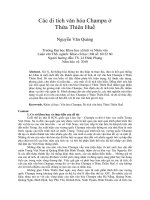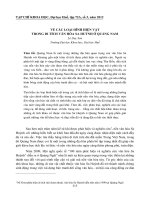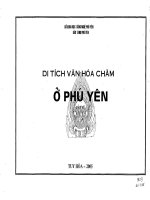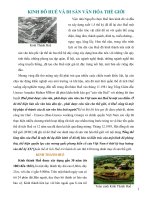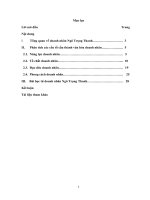Vung dem va di tich van hoa
Bạn đang xem bản rút gọn của tài liệu. Xem và tải ngay bản đầy đủ của tài liệu tại đây (18.74 KB, 3 trang )
THE BUFFER ZONE AND THE PRESERVATION OF
CULTURAL HERITAGE: THE SPANISH CASE
Dr. Luis Anguita Villanueva
I.- INTRODUCTION: A HISTORICAL OVERVIEW
The use of buffer zones in Spanish legislation regarding the protection of the patrimony
originates in the protection standards that were established at the beginning of the
twentieth century for monuments and historical areas. Article 21 of the Real Decreto-
Ley of August 9, 1926, about protection and conservation of artistic richness declared
that in cities and towns which are totally or partially declared as, or that are included in,
artistic national treasures, there will be protection by way of the city plans. Circles were
to be drawn around those places where development was limited, with different colors
for artistic or historic buildings, places, streets, squares, picturesque locations and
central plazas. No development could take place without the authorization of the central
authorities or the provincial authorities. Later on, the Law of 13th of May 1933, article
33, and the Decreto of 16 of April 1936 confirmed complete protection of immovable
cultural goods through “protection areas”, Spain’s first regulation of buffer zones.
II.- CULTURAL GOODS WITHIN LAW 16/1985
Law 16/1985, dated 25 June, regarding the Spanish Historical Heritage (Official State
Bulletin of 29 June 1985) is the standard for the protection of cultural goods at the
federal level. In this law, we find written in the Preamble that Spanish Historical
Heritage has been the main witness to the historical contributions made by Spaniards to
universal civilization and to its contemporary creative capacity. The protection and
enrichment of the property forming this heritage are fundamental obligations that are
binding for all public authorities, in compliance with the mandate addressed to them by
article 46 of the Spanish Constitution.
This general principle regarding Spanish Cultural Heritage is further explained in the
text of the law, which creates different levels of protection for cultural goods.
1.-Cultural Interest Goods.
2.-Cultural Goods
included in the General Inventory.
3.-Other Cultural Goods.
Only for those goods within the first level does Law 16/1985 offer the possibility of
having a buffer zone or area of protection, given their importance within the Spanish
Historical Patrimony. This first level is made up of natural immovable goods. The
second level includes natural movable goods. The third level is left as a residual
category that refers to certain goods and general obligations of conservation and
protection that Law 16/1985 imposes.
Within natural immovable cultural interest goods, Law 16/1985 defines the following:
1. Monuments comprising architectural or engineering works, as well as colossal
sculptures, shall be monuments provided they are of historical, artistic, scientific or
social interest.
2. A Historical Garden is a delimited area resulting from the organisation of natural
elements by man, sometimes complemented by constructions, and considered of interest
because of its origin or historical past, or because of its aesthetic, sensory or botanical
value.
3. A Historical Area is a group of immovable properties forming a continuous or
dispersed unit of settlement, within a physical structure representing the development of
a human community in that it testifies to its culture or has value for public use and
enjoyment. A historical unit is also any individualized group of properties included in a
larger population unit that have the same characteristics and that can be clearly
delimited.
4. A Historical Site is a place or natural landscape linked to events or memories of the
past or to popular tradition, as well as cultural or natural creations and man-made works
having historical, ethnological, paleontological or anthropological value.
5. An Archaeological Area is a place or natural landscape where there are movable or
immovable properties that can be studied using archaeological methodology, whether or
not they have been excavated and regardless of whether they are to be found on the
surface, underground or below Spanish territorial waters.
III.- CULTURAL INTEREST GOODS AND BUFFER ZONES
Proceedings declaring Cultural Interest Goods must define them clearly. In the case of
immovable properties, it is necessary to delimit a buffer zone affected by a designation
and, where appropriate, to define and list the component parts, as well as any
belongings and accessories included in the declaration.
The proceedings declaring Cultural Interest Goods determine the complete legal rules to
define a cultural property that is an immovable cultural good. See the Annexes for
examples of how the rules are joined a topographical map.
What is a buffer zone in the Spanish legal system? It is a physical space that surrounds
the Cultural Interest Good without having its own cultural value. Its mission is to
provide suitable space for the conservation, protection and contemplation of a Cultural
Interest Good.
The legal rules governing buffer zones are spread around Law 16/1985 regarding the
Spanish Historical Heritage. We can describe the most important guidelines within the
law:
a) Both Cultural Interest Goods and Buffer Zones are one unit: An immovable
property declared to be of cultural interest is inseparable from its surroundings. It
cannot be displaced or moved unless this is essential for reasons of force majeure or
social interest.
b) Under all circumstances, authorisation must be obtained from the
Administration for any activity on Buffer Zones: With Cultural Interest Goods, no
internal or external building work may be carried out that will directly affect the
building or any of its parts or belongings without express authorisation from the
Administration responsible for enforcement of Law 16/1985. The same authorisation is
necessary for placing any type of sign or symbol on facades or roofs and for carrying
out any work in the surrounding area covered by the declaration.
c) Urban and Rural Planning can fulfil the role of Buffer Zones:
the Plan for the
protection of a historical unit may allow urban remodelling but only when this implies
an improved relationship with the territorial or urban surroundings or avoids any use
that is damaging for the unit.
d) Benefits are also for the Buffer Zones: The budget for any public works that
are financed completely or partially by the State shall devote at least 1% of the funds
provided by the State to financing work on the preservation or enrichment of the
Spanish Historical Heritage or for promoting artistic creativity, preferably on the actual
site of the work or in its immediate surroundings.
IV.- SOME EXAMPLES OF BUFFER ZONES IN WORLD HERITAGE
MONUMENTS
a) Buffer zones in urban area: Works of Antonio Gaudi in Barcelona.
ANNEXE 1
b) Buffer zones in rural area: San Millan, Yuso and Suso Monasteries
ANNEXE 2
c) Problems with the buffer zones and World Heritage Goods: the special case of The
Route to Santiago.
ANNEXE 3




